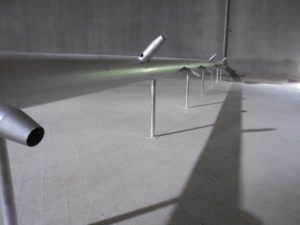
Jet Mixers are widely used in both municipal and industrial wastewater treatment facilities to blend the plant influent and suspend light organic solids in circular equalization tanks. Other applications for these powerful hydraulic mixers include mixing anoxic tanks and anaerobic reactors with the latter application being for industrial waste streams only. Jet mixers are the technology of choice based on their flexibility of operation and configuration in small and large diameter tanks, the highly corrosion and abrasion resistant in-basin components, the use of simple external pumping systems, and a +20-year design life.
When designing jet mixing systems there are four key design criteria that need to be considered and a properly designed jet mixing system will consider all the above criteria balancing which ones are most important for the best results:
- Mixing Intensity: Also referred to as power density this parameter measured in Bhp/MG (W/m3) is a useful tool in sizing Eq. Tanks, Anoxic Tanks and Anaerobic Reactors. Mixing intensity ranges are based on specific wastewater characteristic (TSS concentration for example), tank volume, and hydraulic retention time.
- Distribution of Mixing Energy: One of the true advantages of jet mixing technology is the ability to distribute the mixing energy from one pump to as many as 100 different locations across the area of the tank. This is a key feature for suspending light solids and maximizing liquid blending.
- Turnover Time: Is calculated by dividing the total circulation rate generated by the jet mixer into the tank volume at maximum liquid depth. As a rule of thumb a bulk fluid volume is considered completely mixed if there are 3-5 turnovers per HRT.
- Bulk Fluid Velocity: The thrust imparted on the bulk fluid as the liquid exits the jet creates a small head gain while producing a mostly horizontal velocity. Projecting the fluid velocity is a key design consideration for light solids suspension. There are a series of equations available to estimate the bulk fluid velocity and the best way to guarantee results is to have the design confirmed by Computational Fluid Dynamics (CFD) modeling.




